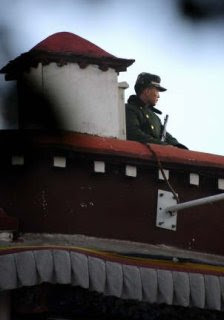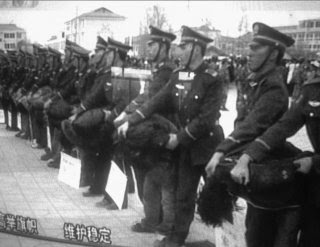Agam's Gecko


Monday, March 09, 2009
NEW YEAR BRINGS MORE TIBETAN PROTESTS AS MARCH 10 LOOMS
| M |
ore peaceful protests have been reported from Kardze Prefecture during the first days of the Tibetan New Year. On February 28, a huge Tibetan national flag was hung on the wall of a police station in Lhoba Township, Kardze County. The phrase "Independence for Tibet" was painted in huge red letters just below the flag. This township was one of two locations mentioned by name in a Radio Free Asia report (cited here on Friday), in which government-sponsored cultural performances were pre-empted by hundreds of posters urging people not to attend such propaganda shows. Spectators failed to show up for these performances, even at the Kardze County headquarters, and the travelling CCP minstrel shows were abruptly cancelled.
On March 1, the same day that hundreds of monks protested in Ngaba against restrictions of their rights to carry out religious observances, three separate protest demonstrations took place in Kardze calling for Tibetan independence. The first (briefly mentioned in the previous post with reporting by RFA) took place at 10 am at the Su-ngo Township headquarters. Two nuns, Pema Yangtso, 22, and Jampa Lhamo, 36, distributed leaflets and called for the Dalai Lama's return home, respect for human rights and religious freedom, and release of the Panchen Lama and Tibetan political prisoners. The two nuns belong to Shi-lus Hermitage Nunnery, located three kilometres from Kardze town centre. Sources told Voice of Tibet radio service that the nuns are being held in a prison beneath a hospital in Kardze town.
A few hours later at around 1 pm, two students identified as Rinchen Phuntsok, 15, and Tsering Drakpa, 17, along with a monk named Achoe, 22, led a peaceful protest at Kardze County headquarters. The students attend the Chinese Middle School in Kardze County. A third protest that day carried out by an unidentified woman was also reported by local sources, and another solo protest on March 6 was also reported but is unconfirmed. Voice of Tibet reported that these protests all took place on March 5 rather than March 1, and that two monks and three other men were severely beaten up after their protests. VoT also indentified another arrested layperson as Chonyi Gyaltsen, 18, and says that two other men were arrested for protesting on March 6.
"Residents physically wrestled with the monks trying to stop them from a possible shooting by Chinese security forces who were all set to press the trigger. Monks were arguing with their family members who stopped them. Some monks said they are protesting in support of the Kirti monk who immolated himself on [February] 27."
On the first day of Losar (Feb. 25) around 100 monks of Lutsang Monastery conducted a candle-light procession to the Mangra County headquarters and held a vigil there (earlier report here). Times of London now reports that the Lutsang monks will be rounded up today for re-grooving.
The rounding up of 109 monks from Lutsang monastery in Qinghai province, western China, is one of a series of extraordinary security measures being implemented to prevent restive Tibetans from commemorating the anniversary with protests against Chinese rule...Communications networks are being shut down for "routine maintenance" until April 1, and Tibetan web portals have been similarly shut down for "repairs." A Tibetan man who runs the Chomei (Eng: "Lamp") language and culture website was arrested from his home in Kanlho Prefecture (Ch: Gannan Pref., Gansu prov.) on February 26. Kunchok Tsephel's house was ransacked in a search for incriminating material, and his computer seized. Born in 1970, he completed primary and middle school in Machu County, and in 1989 he left his country and enrolled in a Tibetan school in India. After completing his studies in Tibetan and English languages, he returned to Tibet in 1994.
Qinghai provincial officials did not say where the monks who took part in the 30-minute candle-light vigil on February 25 would be taken or for how long. It is common for government teams to enter Tibetan monasteries to carry out “patriotic education” in which lamas are required to pledge their allegiance to Beijing and to denounce the Dalai Lama.
Tsephel was arrested by PSB officials in 1995 and kept in detention for two months, during which he was subjected to torture. In the following years he studied languages in Beijing and Lanzhou, and was later recruited as a Tibetan and English teacher in Machu County. Together with a poet friend, he started the Chomei website in 2005. The site had been harassed by the authorities many times during the past two years.
In Golog, Amdo (ch: Qinghai) a protest broke out yesterday involving dozens of local people, reportedly after police conducted identity inspections of timber-hauling trucks. Early today, several small improvised explosives tore the roofs from a police car and fire truck at the remote Makahe timber farm. No injuries were reported.
Dartsedo (Ch: Kangding), the capital of Kardze Prefecture, has now been declared completely off-limits to foreigners. The town had been the last little bit of Kardze to have remained open until now.
"There is a special situation and we hope you can leave as soon as possible," Zhang Lijuan of the Ganzi prefecture foreign affairs office told Associated Press reporters in Kangding. "Normally, this is an open place and we would welcome you. But because of this special situation, it's not convenient."Riot police and machine gun-toting soldiers now march around in front of the Dartsedo town square.
All the people who work for the local administration had to sign a paper with fingerprints that said that they would not burn incense and pray. The annual worship of the mountain deities and religious activities have also been forbidden in other villages of the region. What do you think when you hear this news my friends?The Kardze County court has sentenced four more nuns for protesting last year. Tashi Lhamo, Serka and Youghal Khando were sentenced to two-year prison terms, while Rinzin Choetso was handed a three-year term. The nuns, from Puru-na Nunnery in Kardze County, were among fifty nuns who protested peacefully at the county headquarters on May 14, 2008. The four are serving their time at a prison in Chengdu. The whereabouts and well-being of seven other nuns from Puru-na still remains unknown.
Three freedom-fighting elders, with 53 years of Chinese jail-time between them, share their memories of Tibet's half century of agony at the Sydney Morning Herald. It's worth a read.
Also worth a read, though I haven't had time yet, is the new report on last year's crackdown published today by the International Campaign for Tibet. A Great Mountain Burned by Fire: China’s Crackdown in Tibet looks to contain new information and new photographs of China's suppression campaign, as well as translations of Tibetan blog posts, emails and articles on the crackdown. Also included are the first translations from the only known book published in the PRC about the uprising.
This collection of writing, 'The Eastern Snow Mountain', by Tibetans still in Tibet was banned almost as soon as it appeared. One of the authors writes: "In a year that turned out to be like a raging storm… how could we remain… in fear. [This work is] a sketch of history written in the blood of a generation."A press briefing on the report was held this morning in Dharamsala, with Tibetan sources present. A press briefing in Brussels will also take place today.
.











 Our way of saying "thanks" in the Thai way. Here a nak muay Thai (kickboxer) offers respect and thanks for his teacher (wai khru) before a match. This is our local variation on the ubiquitous "hat tip" used in general blog culture.
Our way of saying "thanks" in the Thai way. Here a nak muay Thai (kickboxer) offers respect and thanks for his teacher (wai khru) before a match. This is our local variation on the ubiquitous "hat tip" used in general blog culture.








